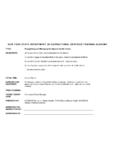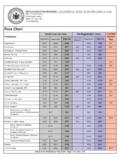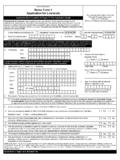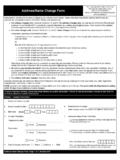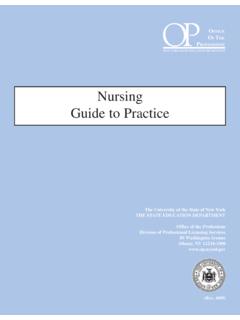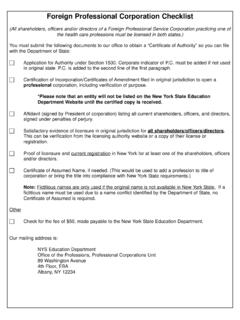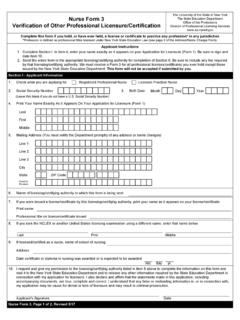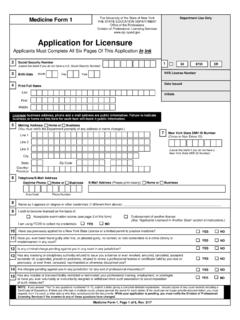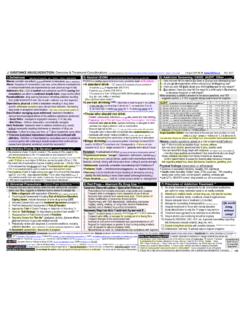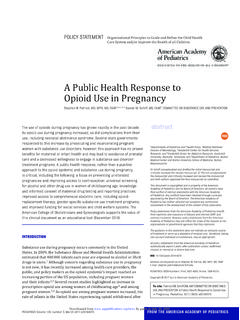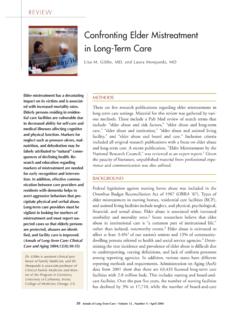Transcription of OASAS Report on the Utilization of Personnel …
1 1. OASAS Report on the Utilization of Personnel Subject to the Provisions of Chapter 132 of the Laws of 2010. Consistent with the provisions of Chapter 132 of the Laws of 2010, the New York State Office of Alcoholism and Substance Abuse Services ( OASAS ) has been tasked with the responsibility of analyzing the composition of its workforce and the nature of work it performs to determine the projected impact of the sunset of the exemption from social work, psychology and mental health licensure which has been in place since 2002. Specifically, Chapter 132 directs OASAS to submit a Report to the Commissioner of Education on the Utilization of Personnel which includes: (1) identification of tasks and activities performed by Personnel that may be restricted to licensed Personnel and those that do not require a license; (2) analysis of costs associated with employing only appropriately licensed Personnel ; and (3) an action plan which details measures to comply with professional licensure laws by July 1, 2013.
2 As OASAS proceeds to implement its plan for the future delivery of professional services, it is important to call attention to what it perceives is an unintended consequence of the passage of Chapters 130 and 132 of the Laws of 2010. That is, in removing the exemption that has existed in the multiple systems that are currently regulated and monitored by seven New York State agencies, this Legislation creates the potential for overlapping and redundant oversight of services funded, regulated or licensed by New York State agencies; sets into motion expectations and Personnel standards that will dramatically increase the cost of publicly funded services; and superimpose an independent practice model into systems that have been built around the multidisciplinary team approach without assessing the impact or effectiveness on service outcomes. Understanding its obligations under Chapters 130 and 132, OASAS believes it is important to articulate these concerns, particularly given the current movement in New York State to eliminate duplication and provide for operational improvements that serve taxpayers at the lowest possible cost.
3 The Report that follows outlines what OASAS believes are the broad parameters of the challenge that Chapter 132 of the Laws of 2010 presents to its system and identifies a reasonable strategy for proceeding. As more accurate and complete information relative to the composition, qualifications and cost of the direct care workforce becomes available, OASAS requests that it have an opportunity to modify its projections and refine its action plan to ensure that the transition to compliance with professional licensure laws may occur without substantially increased cost to the State of New York and disruption in the services available for persons/families with substance use or compulsive gambling related disorders. 2. Introduction and Overview Under its authorization in Section of the New York State Mental Hygiene Law, the NYS Office of Alcoholism and Substance Services ( OASAS ) plans, develops and regulates the state's system of chemical dependence and gambling treatment agencies.
4 This includes the direct operation of 12 Addiction Treatment Centers, which provide inpatient rehabilitation services to 10,000 persons per year. In addition, the Office certifies, funds, and supervises some 1,550 local, community based programs which serve about 110,000 persons on any given day in a wide range of comprehensive services. The agency, in collaboration with local governmental units, also routinely inspects and monitors these programs to guarantee quality care and ensure compliance with state and national standards. OASAS estimates that one in seven state residents ( million) suffer from a substance use disorder (SUD) or problem gambling. The agency estimates that 11 percent, or million, state residents age 12 and older (including 160,000 adolescents ages 12 17) experience a SUD (substance dependence or abuse) annually. Problem gambling, which has been included in OASAS efforts since 2005, is estimated to affect five percent of all adults, over 600,000 individuals.
5 Among adolescents, problem gambling affects 160,000, or one out of every ten youths (an additional 160,000 are at risk of developing problem gambling). Approximately 25 percent of the 160,000 adolescents affected by problem gambling also experience a substance use disorder. These figures do not fully depict the widespread impact of addiction in New York because of the millions of other individuals whose lives are also affected: children, spouses, and extended families. The cost to society is compounded by the consequences of addiction, which affect public safety, health, welfare, and education throughout the state. The workforce that supports and manages the statewide system of addiction services is comprised of approximately 20,000 paid and volunteer addiction professionals who work in a variety of settings, including inpatient, outpatient and residential. In addition to its program monitoring role, the Office also provides education and training for persons dealing with clients; and administers a professional credentialing process for more than 7,500 addiction professionals, including alcoholism and substance abuse counselors, prevention professionals and prevention specialists, and problem gambling counselors.
6 Multi Disciplinary Team Approach The foundation of professional services that are provided in OASAS certified programs is largely based on the concept of the multi disciplinary team. Unlike the service model that is used by licensed independent practitioners, the multi disciplinary team involves the collective expertise 3. of multiple licensed, certified and credentialed professionals who have demonstrated expertise specifically in addiction related disorders. The multi disciplinary team typically consists of: licensed social workers; physicians, registered nurses; credentialed counselors ( , CASACs); family & marriage therapists; certified rehabilitation counselors; and licensed mental health counselors. A multi disciplinary team oversees all cases and approves treatment plans for all patients receiving treatment. The broader multi disciplinary mix of experienced professionals provides an assurance of quality treatment that exceeds the capability of any single Qualified Health Professional and offers a richer blend of expertise and services, assuring that patient needs are met and their overall health and safety is protected.
7 OASAS Clinical Care Workforce The workforce that provides clinical care in the OASAS service delivery system consists of a wide array of professionals with licenses, certifications, credentials and/or specialized training in addiction specific areas that establishes their clinical competency. These professionals provide a range of chemical dependence services within the context of a clinical supervisory structure that includes: screening; intake; orientation; assessment, evaluation and intervention; referral; treatment planning; counseling ( , individual, group and family); crisis intervention; patient education; case management; reporting & recordkeeping; and consultation with other professionals. Within this range of chemical dependence services, functions that will be restricted to licensed professionals are likely to appear. These include: assessment; psychotherapy; diagnosis; treatment planning and treatment (other than psychotherapy). Depending on the program setting and composition of direct care staff, the restricted functions may be performed only by Qualified Health Professionals or by a combination of Qualified Health Professionals and Non.
8 Licensed Direct Care Staff. Qualified Health Professionals include: CASACs, licensed social workers; occupational therapists; physicians; physician's assistants; registered nurses; licensed psychologists; certified rehabilitation counselors; therapeutic recreation specialists; licensed marriage and family therapists and licensed mental health counselors. Non licensed direct care staff are those clinical staff who have qualifications appropriate to their responsibilities and who have completed specialized training in addiction related disorders. Non licensed direct care staff provide clinical services under the supervision of a QHP or otherwise qualified supervisor. OASAS staffing requirements specify that at least 50 percent of all clinical staff in outpatient programs and 25 percent of all clinical staff in residential programs must be QHPs. By far, the most common professional credential in OASAS ' workforce is the CASAC and CASAC Trainee, which together represent more than one third of the OASAS clinical workforce.
9 The 4. most common licensed/certified professions in the OASAS workforce (in order of frequency) include: social workers, RNs, Certified Rehabilitation Counselors, psychologists and mental health counselors. However, the contributions of the non licensed direct care staff continue to be an essential ingredient of the staffing pattern in OASAS programs. These staff support the work of other clinical staff, carry out clinical activities that are less complex in nature and perform their functions under the close supervision of appropriately qualified clinical supervisors. Most importantly, non licensed direct care staff represent a viable candidate pool and training ground for future licensed or credentialed professionals. Future Plans for Delivery of Professional Services OASAS oversees what is recognized to be the nation's largest and most diverse addiction prevention and treatment system. To sustain and strengthen this service delivery system, OASAS has outlined strategic goals that it expects to achieve which have been formally adopted as its agency Dashboard.
10 Included in the Dashboard are several overarching metrics which relate to and support OASAS ' plans for the delivery of professional services going forward. These include: Strengthen addiction services through a comprehensive, integrated culturally competent system that focuses on individual needs and accessibility. Implement increased program oversight and strengthen accountability to ensure culturally competent, quality services. Increase cross systems training to support integrated, culturally competent behavioral health services. Increase full knowledge, expertise and retention of a high performing, diverse staff throughout the field. As OASAS implements strategies to support these metrics, it will need to do so in the context of Chapters 130 and 132 of the Laws of 2010. With this in mind, OASAS envisions three substantive changes in the delivery of professional services in its system. These include: (1) promulgation of counselor scopes of practice in OASAS regulations which authorize permitted activities for counselors, based on education level achieved, professional credential or license status, or qualifying work experience; (2) broader acknowledgement of the multi.
